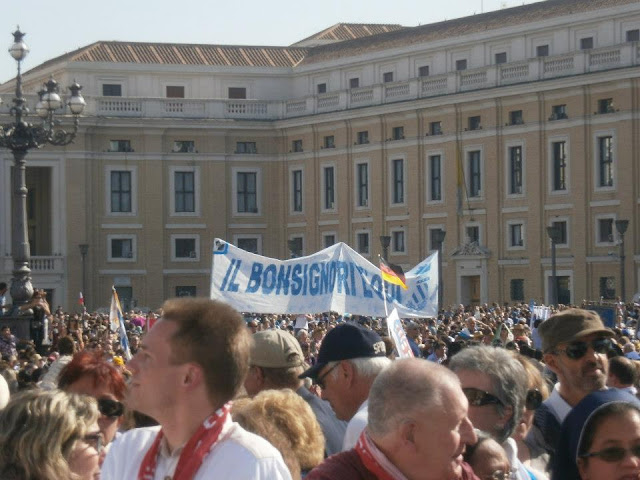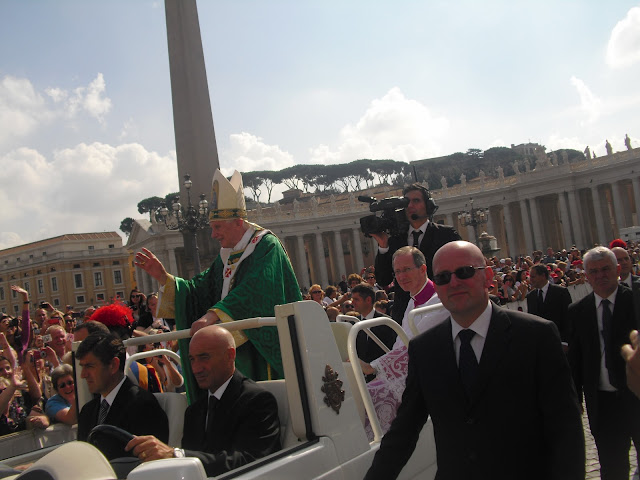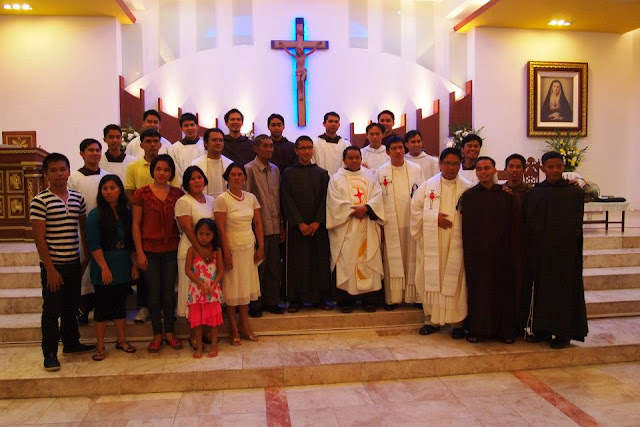Anticipating the dreams of youth for change.
With this statement the II International Congress of Amigonian Pedagogy
was concluded, on Saturday 17, 2012 held at the Bancaja Cultural Centre
in the city of Valencia, Spain. It was participated by teachers,
religious educators from over twenty countries in America, Europe and
Africa and according to the organizers, more than 5,000 were connected
to the congress in 'streaming'.
Thursday, November 22, 2012
Wednesday, November 7, 2012
Saint Pedro Calungsod
The Life and Glorification of Pedro Calungsod
by Msgr. Ildebrando Jesus Aliño Leyson (http://www.pedrocalungsod.org/index.php/life/56)
Pedro Calungsod
was a teenage native of the Visayas region of the Philippines. Very
little is known about him. We do not even know where exactly in the
Visayas he came from or who his parents were. He was just one of the boy
catechists who went with some Spanish Jesuit missionaries from the
Philippines to the Ladrones Islands in the western North Pacific Ocean
in 1668 to evangelize the Chamorros. In that century, the Jesuits in the
Philippines used to train and employ young boys as competent catechists
and versatile assistants in their missions. The Ladrones at that time
was part of the old Diocese of Cebu.
Life
in the Ladrones was hard. The provisions for the Mission did not arrive
regularly; the jungles were too thick to cross; the cliffs were very
steep to climb, and the islands were frequently visited by devastating
typhoons. Despite the hardships, the missionaries persevered, and the
Mission was blessed with many conversions. The first mission residence
and church were built in the town of Hagåtña [Agadña; Agaña; Agana] in
the island of Guam. Subsequently, the islands were renamed “Marianas” by
the missionaries in honor of the Blessed Virgin Mary and of the then
queen regent of Spain, Maria Ana, who was the benefactress of that
Mission.
But
very soon, a Chinese quack, named Choco, envious of the prestige that
the missionaries were gaining among the Chamorros, started to spread the
talk that the baptismal water of the missionaries was poisonous. And
since some sickly Chamorro infants who were baptized died, many believed
the calumniator and eventually apostatized. The evil campaign of Choco
was readily supported by the Macanjas who were superstitious local
herbal medicine men, and by the Urritaos, the young native men who were
given into some immoral practices. These, along with the apostates,
began to persecute the missionaries, many of whom were killed.
The
most unforgettable assault happened on 2 April 1672, the Saturday just
before the Passion Sunday of that year. At around seven o’clock in the
morning, Pedro – by then already about seventeen years old, as can be
gleaned from the written testimonies of his companion missionaries – and
the superior of the Mission, named Padre Diego Luís de San Vitores,
came to the village of Tomhom [Tumhon; Tumon], in Guam. There, they were
told that a baby girl was recently born in the village; so they went to
ask the child’s father, named Matapang, to bring out the infant for
baptism. Matapang was a Christian and a friend of the missionaries, but
having apostatized, he angrily refused to have his baby christened.
To
give Matapang some time to cool down, Padre Diego and Pedro gathered
the children and some adults of the village at the nearby shore and
started chanting with them the truths of the Catholic Faith. They
invited Matapang to join them, but the apostate shouted back that he was
angry with God and was already fed up with the Christian teachings.
Determined
to kill the missionaries, Matapang went away and tried to enlist in his
cause another villager, named Hirao, who was not a Christian. At first,
Hirao refused, mindful of the kindness of the missionaries towards the
natives; but, when Matapang branded him a coward, he got piqued and so
he consented. Meanwhile, during that brief absence of Matapang from his
hut, Padre Diego and Pedro took the chance of baptizing the infant with
the consent of the Christian mother.
When
Matapang learned of the baptism, he became even more furious. He
violently hurled spears first at Pedro. The lad skirted the darting
spears with remarkable dexterity. Witnesses said that Pedro had all the
chances to escape because he was very agile, but he did not want to
leave Padre Diego alone. Those who personally knew Pedro believed that
he would have defeated his fierce aggressors and would have freed both
himself and Padre Diego if only he had some weapon because he was a
valiant boy; but Padre Diego never allowed his companions to carry arms.
Finally, Pedro got hit by a spear at the chest and he fell to the
ground. Hirao immediately charged towards him and finished him off with a
blow of a cutlass on the head. Padre Diego could not do anything except
to raise a crucifix and give Pedro the final sacramental absolution.
After that, the assassins also killed Padre Diego.
Matapang
took the crucifix of Padre Diego and pounded it with a stone while
blaspheming God. Then, both assassins denuded the bodies of Pedro and
Padre Diego, dragged them to the edge of the shore, tied large stones to
their feet, brought them on a proa to sea and threw them into the deep.
Those remains of the martyrs were never to be found again.
When
the companion missionaries of Pedro learned of his death, they
exclaimed, “Fortunate youth! How well rewarded his four years of
persevering service to God in the difficult Mission are; he has become
the precursor of our superior, Padre Diego, in Heaven!” They remembered
Pedro to be a boy with a very good disposition, a virtuous catechist, a
faithful assistant, a good Catholic whose perseverance in the Faith even
to the point of martyrdom proved him to be a good soldier of Christ.
“Martyrdom is the supreme witness given to the truth of the faith: it
means bearing witness even unto death. The martyr bears witness to
Christ who died and rose, to whom he is united by charity. He bears
witness to the truth of the faith and of Christian doctrine. He endures
death through an act of fortitude.” – Catechism of the Catholic Church n. 2473
The
Mariana Mission continued amid turmoil. Meanwhile, the surviving Jesuit
missionaries managed to start the process for the beatification of
their Mission superior Padre Diego on 9 January 1673. Beatification is
the act by which the Church, through papal decree, permits a specified
diocese, region, nation, or religious institute to honor with public
cult under the title “Blessed” a Christian person who has died with a
reputation for holiness. Written testimonies of the missionaries and of
the Mariana natives were gathered to document the martyrdom of Padre
Diego. Naturally, the documentation could not but mention also his lone
companion in martyrdom, the boy from the Visayas, Pedro Calungsod.
However, due to the difficult situation at that time and the eventual
suppression of the Jesuits in the 18th century, the cause for
the beatification of Padre Diego fell into oblivion and, together with
it, the memory of Pedro which went hidden for centuries in the
long-forgotten manuscripts of his companion missionaries.
But
the Faith that was planted in the Marianas in 1668 did not die with
Padre Diego, Pedro and the first missionaries. It remained. It survived.
It grew, thanks to the blood of the martyrs and the perseverance of the
succeeding missionaries. On 17 September 1902, the Marianas became an
Apostolic Prefecture and was separated from the old Diocese of Cebu. On
14 October 1965, Guam became a diocese by the name of “Diocese of
Agaña”. On 8 March 1984, Agaña became an archdiocese.
In 1981, when Agaña was preparing for its 20th
anniversary as a diocese, the 1673 beatification cause of Padre Diego
Luís de San Vitores was rediscovered in the old manuscripts and taken up
anew until Padre Diego was finally beatified on 6 October 1985. It was
his beatification that brought the memory of Pedro to our day.
The
Archdiocese of Cebu, where Pedro belonged by ecclesiastical
jurisdiction, also started to process his beatification cause in 1994.
The endeavor was rewarded when, on 5 March 2000, Pedro Calungsod was
beatified by Pope John Paul II at Saint Peter’s Square in Rome. In his
homily during the beatification, the Pope said, “From his childhood,
Pedro Calungsod declared himself unwaveringly for Christ and responded
generously to his call. Young people today can draw encouragement and
strength from the example of Pedro, whose love of Jesus inspired him to
devote his teenage years to teaching the faith as a lay catechist.
Leaving family and friends behind, Pedro willingly accepted the
challenge put to him by Fr. Diego Luís de San Vitores to join him on the
Mission to the Chamorros. In a spirit of faith, marked by strong
Eucharistic and Marian devotion, Pedro undertook the demanding work
asked of him and bravely faced the many obstacles and difficulties he
met. In the face of imminent danger, Pedro would not forsake Fr. Diego
but, as a ‘good soldier of Christ’, preferred to die at the missionary’s
side. Today, Blessed Pedro Calungsod intercedes for the young, in
particular those of his native Philippines, and he challenges them.
Young friends, do not hesitate to follow the example of Pedro, who
‘pleased God and was loved by him’ and who, having come to perfection in
so short a time, lived a full life.” The feast of Blessed Pedro is
celebrated every 2 April, the anniversary of his martyrdom. If the date
falls within Holy Week or Easter Week, the feast is observed on the
Saturday before Passion Sunday as was 2 April in 1672.
On
21 October 2012, Pope Benedict XVI, in a solemn ceremony at Saint
Peter’s Basilica, will inscribe the name of Blessed Pedro Calungsod in
the Canon or list of Saints and from then on, the teenage Visayan martyr
will be invoked as Saint Pedro Calungsod or San Pedro Calungsod.
“By canonizing some of the faithful, i.e., by solemnly proclaiming that
they practiced heroic virtue and lived in fidelity to God’s grace, the
Church recognizes the power of the Spirit of holiness within her and
sustains the hope of believers by proposing the saints to them as models
and intercessors. The saints have always been the source and origin of
renewal in the most difficult moments in the Church’s history. Indeed,
holiness is the hidden source and infallible measure of her apostolic
activity and missionary zeal.” – Catechism of the Catholic Church n. 828. A more detailed account on Blessed Pedro Calungsod is provided in the manual I. Leyson, Pedro Calonsor Bissaya: Prospects of a Teenage Filippino, The Archdiocese of Cebu, 2000.
Year of Faith
"The
'door of faith' (Acts14:27) is always open for us, ushering us into the life of
communion with God and offering entry into his Church."
---Pope Benedict XVI, Apostolic Letter Porta
Fidei for the Indiction of the Year of Faith
Pope Benedict XVI has announced a Year of Faith that runs from October 11th, 2012 to November 24th, 2013.
This
move is related to two anniversaries. One is the 50th anniversary of
the opening of the Second Vatican Council and the other the 20th
anniversary of the publication of the Catechism of the Catholic Church.
There is also a major event related to the Year of faith which is the
Synod of Bishops on the theme ‘The New Evangelization for the
Transmission of the Christian faith.’
Porta Fidei (The Door of Faith)
The Pope has issued an Apostolic Letter proclaiming the Year of faith titled, ‘Porta Fidei’ or ‘The door of faith.’
He uses the ‘door’ as an image of faith. Paul and Barnabas, returning
after their missionary journey to different lands, sailed back to
Antioch. ‘When they arrived they called the Churches together and
related all that God has done with them and how he opened a door of
faith to the Gentiles’ (Acts 14:27).
The
door ‘is always open for us.’ It welcomes us into a communion with God
and offers entry into his Church. There are two essential elements that
makes possible the entry through this door namely proclamation of the Word of God and allowing the same word to shaping the heart with its transforming grace. Entering this door is a life long journey that begins with our baptism and continues till death to eternal life.
Know the Faith
The document gives beautiful reflections on the theme of faith. Faith is choosing to stand with the Lord so as to live with him.
‘Standing with the Lord’ would signify understanding the reasons for
believing. We must know the contents of faith. Knowing well what exactly
is to be believed is essential for giving one’s own assent that is to
say for adhering fully with the intellect and will to what the Church
proposes.
‘Knowledge of faith opens a
door into the fullness of the saving mystery revealed by God.’
Believing means, ‘we accept the whole mystery of faith.’ Both our
intellect and will must make its choice to believe only then can we feel
comfortable to remain with the Lord.
The acceptance of faith
Focusing
on Jesus is essential to lead a life of true Christian faith. Jesus
attracts to himself people of every generation. It clearly states that
‘The Year of Faith… is a summons to an authentic and renewed conversion
to the Lord the Saviour of the world.’ He is the ‘pioneer and perfecter
of our faith (Heb. 12:2). The reasons for keeping our gaze fixed on
Jesus Christ and contemplating in his Incarnation, death and
Resurrection are:
a) In him all the anguish and all the longing of human finds fulfillment
b) Fulfills the joy of love
c) Gives answer to the drama of suffering and pain
d) The power of forgiveness in the face of offense received
e) The victory of life over emptiness of death
f) The examples of faith that has marked the two thousand years of our salvation history are brought to the fullness of light.
b) Fulfills the joy of love
c) Gives answer to the drama of suffering and pain
d) The power of forgiveness in the face of offense received
e) The victory of life over emptiness of death
f) The examples of faith that has marked the two thousand years of our salvation history are brought to the fullness of light.
The document tells us that By faith, we too live.
It is the living recognition of the Lord Jesus. There are people who
are born and brought up as Christians but are totally ignorant of the
person of Christ. The life, works and message of Christ are alien to
them. This year of faith calls every Christian to recognize this Christ ‘present in our lives and in our history.’
St.
Augustine is given as one of the bright examples of this journey of
faith. The pope tells that ‘his life was a continual search for the
beauty of the faith until such thing as his heart could find rest in
God.’ His extensive writings still help people to find the right path
towards the ‘door of faith.’ This year of faith must turn out to be an
occasion during which the entire Church may undertake a renewed outlook
on the faith by a deeper study of the Christian Doctrine and delve
deeper into the mystery of Christ.
- – - written by Fr. Freddie Pereira SDB (http://www.turnbacktogod.com/the-year-of-faith/)
Bro. Demars Hengoni's Perpetual Profession
"Let us, therefore, have charity and humility and
give alms because it washes the stains of our sins from our clothes. For people lose everything they leave behind in
this world; but they carry with them the rewards of charity and the alms
which they gave, for which they will have a reward and a just
retribution from the Lord." (St. Francis of Assisi)
October 04, 2012 Feast of St. Francis of Assisi and Perpetual profession of Bro. Demars Hengoni, TC
Fr. John Jayoma as a new Parish Priest of MDP
“I am the good shepherd,
and know my sheep,
and am known of mine." John 14
and know my sheep,
and am known of mine." John 14
We share in the universal mission of the church with the specific character transmitted by our founder: re-education of youth.
Subscribe to:
Comments (Atom)






















